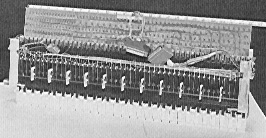
Science Dimension volume 4 issue 2 April 1972
It's the only one of its kind. It slurs, it slides; it's classical, jazz and rock; it can sound like an ancient reed instrument, a mediaeval stringed instrument, or a space ship travelling through the atmosphere. It's called the Sackbut and it's destroying the limitations of all previous keyboard instruments.
 |
. |
| Above: Close up of the interior of the Sackbut (NRC) |
Invented by Dr. Hugh LeCaine of the National Research Council of Canada's Radio and Electrical Engineering Division, this electronic monophonic instrument places continuity of pitch, intensity and tone color within fingertip reach on a keyboard the size of small electric organ.
"It's a superb instrument," says Dave Wilson, President and founder of Dayrand Limited, Montreal, the company which is manufacturing the Sackbut under licence from Canadian Patents and Development Limited, a subsidiary of NRC which patents government-owned inventions and licenses them to industry. "We're naturally excited about it because it's Canadian and we're Canadian, but we're aiming it at the world market."
Electronic experiments began about the turn of the century. Previously, music making was limited by the mechanical qualities of instruments and the physical capabilities of the performers. But the first real breakthrough occurred in France in 1948 with the idea that sounds could be treated as sound objects, or pieces of sound recorded on tape. Once recorded, these pieces could then be subjected to all kinds of treatment - speeded up, played backwards or cut in half. The idea caught on very quickly and composers all over the world were trying it. Music probably never will be the same again. New sounds and new notations have influenced modern orchestral scoring as well as expanding the field of electronic music.
Dr. LeCaine began work privately on the Sackbut in 1945. Nine years later, NRC entered the picture, encouraging the project as a form of communication between Canadian artists and scientists.
"My primary concern," says the musician-physicist, "was making an electronic instrument that was musically expressive. I felt that all previous electronic instruments were cold and mechanical. I thought that we must have some means of controlling the sound in an artistic way."
Dr. LeCaine has achieved just that. The Sackbut is extremely touch sensitive, so that the emotion and musical expression of the instrumentalist becomes very important. A composer can externalize his musical ideas through the keyboard, communicating changes in mood and feeling directly and continuously. As a monophonic instrument, the Sackbut plays only a single note at a time. But unlike other instruments with a keyboard, it can slur and slide from note to note, produce continuously variable sounds in real time and constantly adjust tone, color and pitch. It has definite uses as a part of musical groups - rock bands, classical or jazz groups or an electronic group. It can adapt virtually to every kind of music. In addition, the Sackbut does not go out of tune from heat affecting voltage circuits. It is a great deal smaller, more compact, less temperamental and cheaper than many synthesizers (instruments consisting solely of electronic sound generators with tone modifiers and other controls). With the Sackbut, the player does not have to stop to rearrange electrical cords to control the sound.
Perhaps the Sackbut's best feature, according to musicians who have played it, is the way in which a player can make a note louder by pressing the key harder or make it waiver (vibrato) with a sideward movement of the finger. Twenty-four controls can break up and bend notes, creating repetitive patterns into which other notes fit, producing the effect of more than one note playing at the same time.
Says Peter Jermyn, Ottawa composer and arranger: "It's the sort of instrument I've always been looking for. It's not really a synthesizer, but it can do things a giant synthesizer is incapable of, at a fraction of the cost and in a portable framework."
Initially, a small number of machines will be produced by Dayrand, selling for about $2,500 each (the cost of large synthesizers start at about $8,000 each).
"This is a conservative approach," says Mr. Wilson, "but it's more of a sampler to determine whether changes will have to be made for marketability. Signs are promising for it's acceptance. To date a number of studios and individual musicians have shown a marked interest in it."
Engineers and scientists also have expressed interest. The NRC prototype was featured at Stereo '72 in Montreal, Que., at Toronto's International Electronic Exposition, at the Canadian Electronic Design Display and at Stereo '72 in Ottawa.
In addition, the Sackbut has been used for the musical scores of several films. The theme music for NBC's children's science program, Mr. Wizard, was written and played by Mr. Jermyn using the Sackbut and he-has composed an electronic symphony on the Sackbut which was used to form part of an audio-visual show at Place Bell Canada in Ottawa. Mr. Jermyn is working on the sound track for a forthcoming National Film Board movie.
"The future of electronic music is unlimited," he says.
Reprinted courtesy of National Research Council of Canada